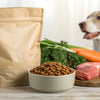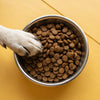How Much Wet Dog Food is Equivalent to Dry? A Comprehensive Guide for Pet Owners
- Houndsy
Table of Contents
- Introduction
- Understanding the Fundamental Differences Between Wet and Dry Dog Food
- How to Accurately Convert Wet Dog Food to Dry Dog Food Portions
- Why Portion Control is Key: Beyond Simple Volume
- Combining Wet and Dry Dog Food: The Best of Both Worlds?
- Conclusion
Introduction
Have you ever gazed into your dog's food bowl, pondering how much wet food you should serve to replace their usual dry kibble? You’re not alone. The question of how much wet dog food is equivalent to dry is crucial for ensuring your beloved pet receives the right balance of nutrients, calories, and hydration to stay healthy and happy. With countless options available—from crunchy kibble to savory canned meals—navigating the feeding landscape can feel overwhelming.
Feeding dogs is not just a daily routine; it’s a fundamental aspect of their health and well-being. Understanding the conversion between wet and dry dog food is essential for maintaining their nutrition, especially when considering switching between the two. As pet parents, we want to provide the best for our furry friends, and that starts with proper feeding practices.
In this blog post, we’ll explore the nuances of wet versus dry dog food, explain how to accurately convert quantities between the two, and share actionable tips that can simplify your dog-feeding routine. We'll also discuss why portion control matters and how tools like the Houndsy Kibble Dispenser can enhance your feeding experience. Let’s delve into this essential topic together, reflecting on our current feeding routines and how we can improve them.
Understanding the Fundamental Differences Between Wet and Dry Dog Food
Before we can accurately convert wet dog food to dry, it’s important to understand the intrinsic differences between the two types of food.
Moisture Content
The most apparent difference is moisture content. Wet dog food typically contains about 75-80% water, while dry dog food (kibble) has only about 10-12% moisture. This means that a cup of wet food appears larger by volume but contains significantly fewer calories than a cup of dry kibble.
Nutritional Density
Nutritional density varies greatly between wet and dry foods. Dry kibble is often more calorie-dense, providing more concentrated nutrients in a smaller volume. For example, a cup of dry food can contain anywhere from 300 to 500 calories, while a can of wet food might offer only 200 to 350 calories. When switching between the two, simply measuring by volume could lead to over or underfeeding.
Texture and Palatability
Wet food is typically softer and more aromatic, making it appealing to picky eaters or dogs with dental issues. The texture can facilitate easier chewing and swallowing. Conversely, dry kibble can help maintain dental health by scraping plaque off teeth as dogs chew.
Shelf Life and Storage
Dry food has a longer shelf life and is easier to store. It can be left out without spoiling, while wet food must be refrigerated once opened and typically needs to be consumed within a few days. This can pose practical challenges for pet owners who may face mess and waste with wet food.
Summary of Key Differences
- Moisture Content: Wet food (75-80% water) vs. Dry food (10-12% water).
- Nutritional Density: Dry food is more calorie-dense.
- Texture: Wet food is softer and more appealing to some dogs.
- Shelf Life: Dry food lasts longer and is easier to store.
Understanding these differences is essential as we dive into the specifics of how much wet dog food is equivalent to dry.
How to Accurately Convert Wet Dog Food to Dry Dog Food Portions
Converting wet dog food to dry involves understanding caloric intake rather than simply focusing on volume. Here’s a step-by-step guide to help you navigate this conversion accurately:
Step 1: Check the Caloric Information on Packaging
Start by examining the packaging of both your wet and dry dog food. Look for the caloric content, typically expressed as kcal per cup for dry food and kcal per can or ounce for wet food. If this information is not readily available, visiting the manufacturer's website or contacting their customer service can provide clarity.
Step 2: Calculate the Equivalent Caloric Intake
Let’s say your dog normally eats 1 cup of dry food that contains 400 kcal. To find out how much wet food you need to match this caloric intake, check the calorie content of the wet food. For instance, if a 13 oz can of wet food contains 350 kcal, you’d need approximately 1.14 cans of wet food to provide the same caloric intake as 1 cup of dry food.
Step 3: Adjust According to Your Dog’s Needs
Keep in mind that caloric requirements depend on your dog’s age, weight, activity level, and overall health. Always consult your veterinarian for personalized advice. Monitoring your dog’s weight and adjusting portions accordingly is essential for maintaining their optimal health.
Step 4: Account for Feeding Frequency and Your Routine
Dogs often thrive on multiple smaller meals throughout the day rather than one large meal. You can divide their total daily caloric intake across meals. For example, if your dog requires 800 kcal per day, you could provide them with four meals of 200 kcal each, adjusting the mix of wet and dry food accordingly.
Common Conversion Guidelines
While every brand may differ in calorie content, here are some general guidelines to assist in your conversions:
- 1 cup of dry kibble = approximately ¾ to 1 can of wet food (13 oz), depending on caloric density.
- For a mixed diet, you might try a ratio of 50% wet food to 50% dry food.
Summary
To accurately determine how much wet dog food is equivalent to dry, focus on caloric content rather than volume. This approach ensures you are providing a balanced diet tailored to your dog’s needs.
Why Portion Control is Key: Beyond Simple Volume
Portion control is a fundamental pillar of good dog care. It prevents health issues and supports overall well-being. Let’s break down why portion size matters and how it plays a crucial role in your dog’s diet.
The Risks of Overfeeding and Underfeeding
Overfeeding can lead to obesity, which is linked to various health issues, including diabetes, joint problems, and heart disease. Conversely, underfeeding can result in malnutrition, leading to deficiencies in essential nutrients, poor energy levels, and compromised immune function.
Maintaining Ideal Body Condition
Monitoring your dog’s body condition score (BCS) is essential for maintaining their ideal weight. Regular weigh-ins and visual assessments can help determine if your dog is at a healthy weight. Adjusting portion sizes based on BCS can help prevent health complications and support a longer, happier life.
The Role of Measurement Tools
Using precise measurement tools is crucial in maintaining portion control. The Houndsy Kibble Dispenser, for instance, is designed to simplify your dog-feeding routine. With its ergonomic crank and large capacity for storing 25-30 lbs of kibble, it allows you to dispense accurate portions conveniently—without the mess and guesswork.
Summary
Understanding portion control is vital for your dog’s health. Utilizing tools like the Houndsy Kibble Dispenser ensures you provide accurate portions, supporting your dog’s well-being and making mealtime more enjoyable.
Combining Wet and Dry Dog Food: The Best of Both Worlds?
Mixing wet and dry dog food can be beneficial for both nutrition and convenience. Let’s explore the advantages of combining the two.
Enhanced Palatability
Many dogs find wet food more appealing due to its aroma and texture. By mixing it with dry kibble, you can entice picky eaters while maintaining the benefits of both food types. This approach helps ensure that your dog receives a balanced diet with the hydration benefits of wet food.
Balanced Nutrition
Combining foods can help balance nutrients effectively. Dry kibble is often fortified with vitamins and minerals, while wet food can provide additional moisture. This combination can help meet your dog's nutritional needs, especially during hot weather when hydration is crucial.
Practical Feeding Tips for Combining Wet and Dry Food
- Start Slowly: If your dog is new to mixed feeding, introduce wet food gradually to avoid digestive upset.
- Monitor Portions: Follow the caloric conversion methods discussed earlier to maintain balanced nutrition.
- Watch for Changes: Keep an eye on your dog’s weight and digestion when making dietary changes, adjusting portions as necessary.
Houndsy’s Commitment to Making Feeding Easy and Beautiful
At Houndsy, we understand the challenges pet parents face with daily feeding—from inconsistent portions to messy setups and uninspiring designs. That’s why we created the Houndsy Kibble Dispenser, combining mid-century modern style with ergonomic convenience. Simplifying your dog’s feeding routine frees more time for what matters—making memories with your furry best friend.
Summary
Mixing wet and dry dog food can enhance palatability and nutrition. By following proper feeding guidelines and utilizing tools like the Houndsy Kibble Dispenser, you can create a balanced, enjoyable feeding routine for your dog.
Conclusion
Understanding how much wet dog food is equivalent to dry is essential for maintaining your pet’s health and well-being. By focusing on caloric content rather than simple volume, monitoring portion sizes, and considering a mix of both food types, you can ensure your furry friend receives the nutrition they need.
Investing in tools like the Houndsy Kibble Dispenser not only simplifies your feeding routine but also enhances the overall experience—making mealtime convenient, consistent, and stylish.
As we reflect on our feeding practices, let’s ask ourselves: How precise is your current feeding routine? Would embracing consistent portion control and an ergonomic design improve your daily life and your dog’s health? Explore how Houndsy can transform mealtime for you and your pup.
FAQ
Q: How much wet dog food equals 1 cup of dry dog food?
A: The amount varies depending on specific products’ calorie content. Generally, one 13-ounce can of wet food is equivalent to about ¾ to 1 cup of dry kibble by caloric value. Always check packaging and caloric info for accuracy.
Q: Is it okay for my dog to eat only wet food?
A: Yes, dogs can eat wet food exclusively if it’s nutritionally complete and balanced. Wet food offers hydration benefits but may require close attention to dental care and feeding freshness.
Q: Can I mix wet and dry dog food?
A: Absolutely. Mixing can improve palatability and hydration for your dog. Adjust quantities to maintain proper calorie intake and monitor your dog’s digestion and weight.
Q: Why is portion control important when switching between wet and dry dog food?
A: Portion control ensures your dog receives balanced nutrition without excess calories, preventing obesity or malnutrition, which can lead to serious health issues.
Q: How can I simplify feeding dry kibble with portion control?
A: Tools like the Houndsy Kibble Dispenser provide precise, ergonomic, and mess-free dispensing, ensuring you maintain accurate portions with every meal.












